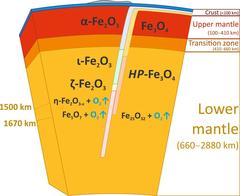URL: https://www.desy.de/news/news_search/index_eng.html
Breadcrumb Navigation
DESY News: Discovery of new iron oxides points to large oxygen source inside the Earth
News
News from the DESY research centre
Discovery of new iron oxides points to large oxygen source inside the Earth
Using a special high-pressure chamber, scientists have discovered two new iron oxides in experiments at DESY's X-ray light source PETRA III and other facilities. The discovery points to a huge, hitherto unknown oxygen source in the lower mantle of the Earth. The team led by Dr. Elena Bykova from the University of Bayreuth reports its results in the scientific journal Nature Communications.

Structure of the newly discovered iron oxide Fe25O32. Credit: Elena Bykova, Universität Bayreuth
„In this so-called diamond anvil cell, a minute sample can be compressed between two diamonds to several hundred thousand times the atmospheric pressure while a meticulously aligned laser can also heat the sample through the transparent diamond anvils to several thousand degrees Celsius,“ explains DESY scientist Dr. Hanns-Peter Liermann, head of the measuring station and a co-author of the paper. At the same time, the exceptionally bright and small X-ray beam of PETRA III can track structural changes in the sample. Similar measurements were also made at the European Synchrotron Radiation Source ESRF in France and at the Advanced Photon Source APS in the US.

The previously unknown iron oxide Fe5O7 forms under pressures of more than 67 gigapascals and temperatures of more than 2400 degrees Celsius from hematite. Credit: Elena Bykova, Universität Bayreuth
Although iron oxides do not normally exist in the bulk of the Earth’ lower mantle, they can be transported there via subduction zones, where one tectonic plate dives under another. Hematite and magnetite are major components of so-called Banded Iron Formations (BIFs) and ironstones, huge sedimentary rock formations occurring on all continents. These formations may reach up to several hundred meters in thickness and hundreds of kilometres in length.Deposited in the world’s oceans about two billions years ago, Banded Iron Formations form part of the ocean floor and are recycled into the Earth’s interior by subduction to great depths, possibly extending to the core-mantle boundary region.

Iron oxides can be carried deep into the Earth's mantle via subduction zones, where one tectonic plate slides under another. At sufficient pressure and heat, hematite and magnetite decompose to form new iron oxides, thereby releasing large quantities of oxygen. The fate of this oxygen has yet to be explored. Credit: Elena Bykova, University of Bayreuth
The oxygen-rich fluid could either locally oxidize surrounding materials or pass to the transition zone, or even to the upper mantle. “This remains to be explored”, says co-author Dr. Maxim Bykov of the University of Bayreuth. “For now, we can only say that there is a huge source of oxygen in the mantle that can significantly affect geochemical processes by changing oxidation states and mobilizing trace elements. This will open a large new field of modelling.”
The discovery of the new iron oxides thus not only adds to the knowledge about fundamental characteristics of these substances, underlines Bykov. “Our work shows that we maybe miss significant parts of the processes in the Earth. Subducted slabs can apparently produce unexpected things. The effects on Earth's global dynamics, including climate variations, have to be investigated.”
Reference:
Structural complexity of simple Fe2O3 oxide at high pressures and temperatures; Elena Bykova et al.; Nature Communications, 2016; DOI: 10.1038/NCOMMS10661



